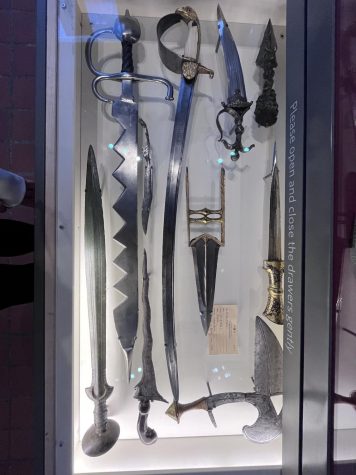A Weapon’s Rank: AP Lang Path Making Essay
 “Let him who desires peace prepare for war,” were the famous words of Roman army general Publius Quinctilius Varus. Roman general Varus had a prized weapon, his gladius. A Roman gladius was a small metallic sword, about 60 centimeters long, with a sharp pointed end and a golden, intricately embellished, carved wooden handle. Not one blemish damaged the surface of the metal. On exhibit at the Worcester Art Museum’s John Higgins Armory Collection, Varus’ gladius was displayed in a drawer alongside an array of ancient Roman weapons.
“Let him who desires peace prepare for war,” were the famous words of Roman army general Publius Quinctilius Varus. Roman general Varus had a prized weapon, his gladius. A Roman gladius was a small metallic sword, about 60 centimeters long, with a sharp pointed end and a golden, intricately embellished, carved wooden handle. Not one blemish damaged the surface of the metal. On exhibit at the Worcester Art Museum’s John Higgins Armory Collection, Varus’ gladius was displayed in a drawer alongside an array of ancient Roman weapons.
What dominated the displayed array of weapons was a Venetian boarding sword, used most commonly in naval battles. It was two feet in length and the handles’ curved edges melded into spiked iron wedges. The saw-toothed edge was useful for chopping the ropes of an enemy’s ship.
Alongside the boarding sword, another weapon whose uniqueness shone along its shiny silver facets was an ancient Rajasthani weapon called a katar. It had an elegant golden, H-shaped handgrip, with a triangular mount over it. A katar blade is held between the fingers, resulting in the blade going over the knuckles, making it an ideal weapon for quick-defense.
Despite their ancient origins, these weapons are polished to perfection and because of their subtle wear, they do not look like they have been used in battle. Each weapon features some sort of golden embellishment and intricate detail, as if made specifically to be showcased by a high-ranked, affluent leader. Historically, in large empires, there are different ranks of officials. The hierarchy of respect in an empire extends from everyday men who enlist to fight in battle to the privileged commanders of the higher ranks. High ranked officials’ golden weapons give them an unspoken power over those of lower standing which they command.
 In the same John Higgins Armory Collection at the Worcester Art Museum, alongside the displays of exquisitely crafted, golden weapons was a stand displaying a dagger. It was about 20 centimeters in length, and its cheap copper finish was rusted over, leaving behind a dark green tinted and black speckled piece of metal. Its short brittle handle was attached to a frail blade which resembled that of a butter knife used to spread marmalade on toast. This dagger was meant to be used by lower ranked Roman soldiers in battle. Because there were so many lower ranked soldiers in the Roman Empire, they were provided only with a limited arsenal of weapons. These weapons were usually made of cheaper, unreliable metals in comparison to higher ranked generals’ elegantly golden, indestructible arsenals. Weapons like this rusted dagger were basically useless on the battlefield. However, most soldiers were equipped with unreliable weapons in order to defend themselves. In contrast, high-ranking officials who did not fight but commanded were equipped with exquisitely refined weapons.
In the same John Higgins Armory Collection at the Worcester Art Museum, alongside the displays of exquisitely crafted, golden weapons was a stand displaying a dagger. It was about 20 centimeters in length, and its cheap copper finish was rusted over, leaving behind a dark green tinted and black speckled piece of metal. Its short brittle handle was attached to a frail blade which resembled that of a butter knife used to spread marmalade on toast. This dagger was meant to be used by lower ranked Roman soldiers in battle. Because there were so many lower ranked soldiers in the Roman Empire, they were provided only with a limited arsenal of weapons. These weapons were usually made of cheaper, unreliable metals in comparison to higher ranked generals’ elegantly golden, indestructible arsenals. Weapons like this rusted dagger were basically useless on the battlefield. However, most soldiers were equipped with unreliable weapons in order to defend themselves. In contrast, high-ranking officials who did not fight but commanded were equipped with exquisitely refined weapons.
Simply by examining the composition of the weapon’s materials, viewers can understand the power structure of the Roman empire. Higher ranked officials kept opulent weapons which they did not use for self-defense, but instead kept as showpieces, which are spotless after centuries of their initial production. These higher ranked officials commanded lower ranked persons in war. The lower ranked soldiers were given small, cheaply made weapons to use to win battles for their empire. While the higher ranked commandants, who risked very little, are credited for the expansion of the Roman Empire, no one ever acknowledges or respects lower ranked officials who put their blood, sweat, and tears into winning a war they get no recognition for.
Standing in the John Higgins Armory Collection I studied both the pristine and tarnished weapons from the same time period, which were used in the same battles, but held by different ranks of people. Some weapons were held as ornamentation, while others were utilized for the purpose of self-defense. Our perception of famous generals, like Publius Quinctilius Varus, is that they fought bravely in contribution to the expansion of their empires, but in reality they did not contribute anything. We fail to recognize soldiers who actually fought, and who actually made the Roman Empire as powerful as it is known to be today. If it was not for lower ranked soldiers’ contribution to Roman expansion, the empire would not be adorned as highly in history as it is today.







Kenerson • Jan 17, 2023 at 12:01 PM
Very cool. I wish all the weapons were on full time display.